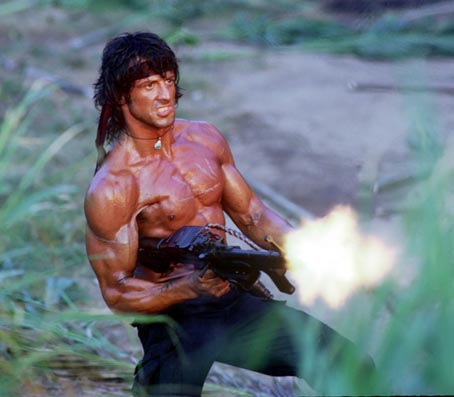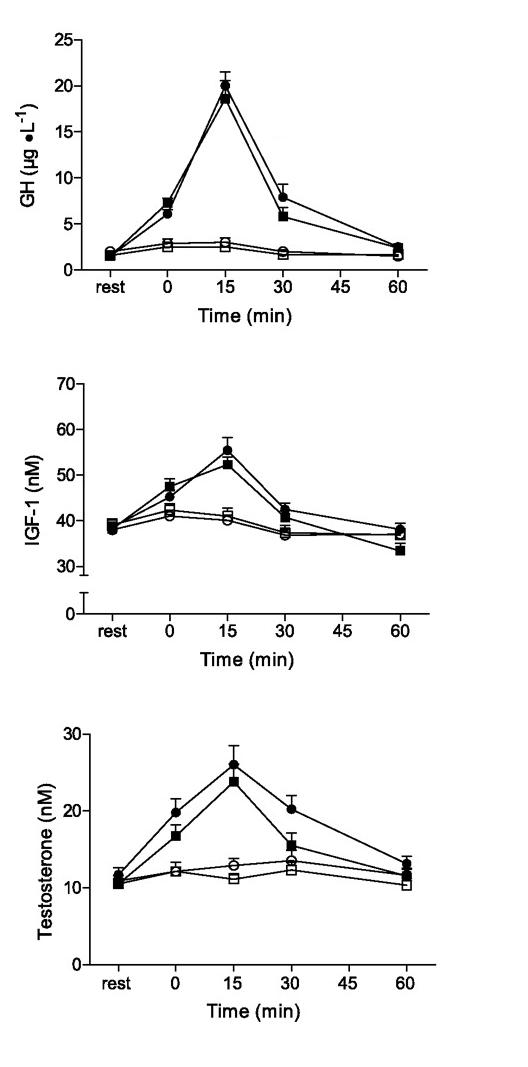Do whole body increases in anabolic hormones provide more muscle growth or strength?
“Welcome to Sydney, Mr. Stallone. Anything to declare?”
“Nope.”
“Hmmm… what about these 48 vials of growth hormone?”
Awkward!
Yes, in 2007, Customs officials seized 48 vials of the banned human growth hormone from Mr Stallone while he was visiting Australia to promote his latest Rocky movie. He was later convicted of importing a banned growth hormone into Australia and ordered to pay more than £5,000 in fines.

Makes a good news story, but do you know what growth hormone is or what it does?
Growth hormone is part of a group of hormones known as anabolic (building-up) hormones. This group also includes insulin-like growth factor-1 (IGF-1) and testosterone. These hormones are important for muscle growth; and they all increase when you weight train.
Anabolic hormones
Growth hormone
Growth hormone, as the name suggests, is a hormone that triggers growth, especially in children.
If you have too little GH when you’re growing up you’ll be shorter (this is what happens in dwarfism). If you have too much in childhood (gigantism) you’ll end up tall – like over 7 feet (2.13 metres) tall! If you have too much as an adult, you’ll end up with acromegaly.
Your pituitary gland makes and secretes growth hormone, which then goes on to do many different things to a bunch of different cells (bone, immune cells, skeletal muscle skeletal, fat cells and liver cells).
Growth hormone particularly affects metabolic functions involved in materials use and storage, such as glucose use and glycogen production; amino acid metabolism and protein synthesis; and fatty acid use/fat breakdown. It helps us use available fuel more effectively.
It also enhances the construction of structural elements such as collagen production (which helps build cartilage) and bone growth.
Growth hormone does one more thing that is really important for those of us who work out: it activates insulin-like growth factors (IGFs). I’ll explain more about IGFs in the next section.
Now, you probably look at the list of all the things growth hormone does and think hey, this sounds great! How do I get more?
Well, there are two ways you can get your body to make more: sleep and exercise (I’ll talk about exercise a bit later on).
If you didn’t have enough reasons to get more sleep, here is another one: about an hour after you fall asleep at night, you get one big burst of growth hormone and then about every four hours you get smaller bursts of growth hormone.
Thus, the more you sleep the more growth hormone you get. Hooray for sleep!
Insulin-like growth factor-1 (IGF-1)
There are a few different insulin-like growth factors (IGFs), but the most famous and best understood is IGF-1 (the number 1 is just because it was first discovered).
IGF-1 comes out to play when growth hormone knocks on the door of the liver, but its takes about 8-29 hours for IGF-1 to get ready.
When you exercise, the amount of IGF-1 in your blood goes up right away, so it must be coming from other places too — two of those places are fat and muscle. IGF-1 triggers a chain of events that makes your muscle make more protein.
Testosterone
Finally a hormone you remember from high school (and you thought sex ed was a waste of time). To refresh your memory, testosterone is the main hormone that makes men manly. Women do have testosterone, they just have a lot less.
Testosterone can stimulate growth hormone secretion and increase the presence of neurotransmitters at the fibre site, which can help to activate tissue growth. As a steroid hormone, testosterone can interact with nuclear receptors on the DNA, resulting in protein synthesis.
Exercise and anabolic hormones
Resistance exercise (weight lifting) that uses a large amount of muscle mass, moderate-high intensity weights, high volume and short rests between sets gives pretty big increases in growth hormone, IGF-1 and testosterone — at least for about a half an hour after exercise.
So… does this mean that exercise turns us into walking anabolic hormonal soup? Read on.
Research question
This week’s review is a bit controversial, because it goes against what is considered common knowledge and some well respected studies by some big cheeses.
This week’s study tries to figure out whether resistance exercise-induced increases in growth hormone, IGF-1 and testosterone enhance muscle strength and hypertrophy with training. As usual, ignore the title if you want to be surprised at the end.
West DW, Burd NA, Tang JE, Moore DR, Staples AW, Holwerda AM, Baker SK, Phillips SM. Elevations in ostensibly anabolic hormones with resistance exercise enhance neither training-induced muscle hypertrophy nor strength of the elbow flexors. J Appl Physiol. 2010 Jan;108(1):60-7.
Methods
Participants
For this study the participants:
- were 12 healthy males
- had an average age of 21 years old
- had an average BMI of 23.1 (normal)
- weighed, on average, 74.1 kg (163.4 lb) and were 1.78 m (5′ 10”) tall
Workouts
In order to get what they were after, the researchers designed a very specific workout program that is going to sound a bit wacky to you.
The workouts were split into two days; day 1 arm (not arms), day 2 arm + legs. Yes, two separate days with one day for each arm.
Why? The researchers wanted to know if increasing blood levels of growth hormone, IGF-1 and testosterone would make the arm being trained that day even bigger than just training.
The arm that was worked out right before legs were trained would have the added benefit of getting exposed to more growth hormone, IGF-1 and testosterone than the arm that was trained without legs.
If you take the hormone levels into account the two workout days can be summarized this way:
Day 1. Arm training: low blood growth hormone, IGF-1 & testosterone levels (low hormone day or LH)
Day 2. Arm + leg training curl: high blood growth hormone, IGF-1 & testosterone levels (high hormone day or HH)
The study had 15 weeks of training with some changes to how often the participants trained.
Weeks 1-6 : the participants worked out three times a week — MondayHH, TuesdayLH, FridayHH, MondayLH, ThursdayHH, FridayLH.
I’d like to point out something here: in the first 6 weeks, two of the three low hormone days were right after the high hormone day with no day in between. Since growth hormone takes up to a day to stimulate IGF-1, this could be a problem.
Weeks 7-15: the participants worked out four times a weeks (each arm twice) — MondayHH, TuesdayLH, ThurdayHH, FridayLH.
Same problem here: the low hormone sessions are the following day after a high hormone session.
Workouts for the arm were isolated arm curls with 3 to 4 sets of 8-12 reps with a weight that was 95% of what they could lift 10 times (95% of 10 RM – rep max).
Leg training was 5 sets of 10 reps of leg press and 3 sets of 12 of leg extensions and leg curl supersets (no rest between exercises) at 90% of 10RM.
Rest between sets: 2 minutes between arm sets and 1 minute between leg sets.
Pre & post workout nutrition
In this study, researchers had the participants drink 18 grams of whey protein right before exercise and another 18 grams of whey 90 minutes after the last set of the arm exercises.
Results
Figure 1 (below) charts changes in growth hormone, IGF-1 and testosterone after the workouts. High hormone workouts are black circles and squares; low hormone workouts are white circles and squares.

All hormones show a peak in the high hormone group (the black circles & squares), but the low hormone group (the white circles & squares) don’t have a peak — all the hormones stay about the same.
Oh, the circles and squares are before and after the 15 weeks of training, and as you can see, there was no difference because of training.
This means that the researchers got what they wanted, which was one workout with high hormones and one with low hormones, so the problems I brought up earlier regarding growth hormone “spilling over” to the next day didn’t happen.
Does more growth hormone, IGF-1 & testosterone mean more strength & hypertrophy?
There was no difference in arm strength or hypertrophy between the arm trained with legs (exposed to high hormone levels) and the arm trained all by itself (exposed to low hormone levels).
There were improvements in both strength and hypertrophy after the 15 weeks, but no difference between arms.
Conclusion
Squatting right before doing your arm curls will increase how much growth hormone, IGF-1 and testosterone you have floating around in your body, but it’s not going to help make your guns stronger or bigger than if you did the squats and arm curls on different days.
Here are a few points that may help you understand how more anabolic hormones didn’t seem to mean more muscle mass or strength.
- It’s the short term (30 minutes) whole body increases in growth hormone, IGF-1 and testosterone that made no difference in muscle mass & strength gains.
- The researchers figure (and I agree) that there are still anabolic hormones around when you work out just your arms, but they stay in the arm. The comparison is anabolic hormones locally versus in the whole body. Local anabolic hormones are more than enough to trigger hypertrophy and strength.
- The researchers aren’t delusional; they fully recognize that chronic (long term) increases in these hormones do increase muscle mass and hypertrophy. Chronic exposure to anabolic hormones does increase muscle mass and strength.
This is actually the second article these researchers published looking at anabolic hormones. The first one had pretty much the same set up but they looked at whether there was a difference in how much muscle protein was synthesized (made) by the muscle. Again, just like in this study, they found no difference when there were more anabolic hormones in the blood (whole body) for a short time.
Bottom line
Nobody is arguing the importance of anabolic hormones for increasing muscle mass and strength. (Least of all Sly.)
However, it doesn’t look like temporary (up to 30 minutes post exercise) whole body increases in anabolic hormones provide more muscle growth or strength.
References
Click here to view the information sources referenced in this article.
Learn more
Want to get in the best shape of your life, and stay that way for good? Check out the following 5-day body transformation courses.
The best part? They're totally free.
To check out the free courses, just click one of the links below.




Share